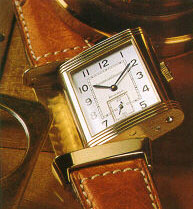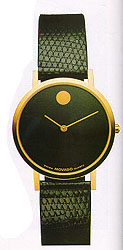The Jaeger-LeCoultre Reverso  A delicate watch crystal is no match for a polo game. That's why a Swiss watch entrepreneur invented a watch that could turn over on its face to protect its crystal from the thwacks and knocks of that most genteel, if not gentle, of sports. A delicate watch crystal is no match for a polo game. That's why a Swiss watch entrepreneur invented a watch that could turn over on its face to protect its crystal from the thwacks and knocks of that most genteel, if not gentle, of sports.
The year was 1930, and Cesar de Trey, a former denture dealer who now made his living devising new types of timepieces and selling them all over the workd, was on a trip to India. There, in a gentlemen's club, some British colonial officers complained to him that their wristwatch crystal shattered with dismaying frequency when exposed to the hazards of a polo game. Of ourse, they could wear covered watches, like the ones soldiers wore in WWI, but military-style watches were so thick and unfashionable. Wasn't there something de Trey could do? Indeed there was. De Trey returned to Switzerland and went to the LeCoultre in turn consulted with the Jaeger firm in Paris, with which it had worked closely for decades (the two firms were to merge in 1937). On March 4, 1931, a patent was filed for a watch "that can be slid in its support and completely turned over." The watch, which de Trey christened "Reverso," was ready by Christmas. Polo players appreciated it, of course, but the watch's special about-face feature appealed to non-athletes, too. People started monogramming the case backs and even illustrating them. The Maharajah of Karputala, one of the richest men in India, ordered 50 Reversos with his picture enameled on them, showing him hovering in the clouds in his saffron robes. When WWII broke out, the Reverso, born in a more refined time, lost its audience. It wasn't until the early '80's, when consumers began to take an interest in wristwatches from the past, that the Reverso's fortunes reversed. Jaeger-LeCoultre resurrected the design, and it is now the company's flagship watch.
Forty years later; the plain, markerless face has become one of the best-known watch designes in the world. It's called the "Museum Watch" because it's in the permanent collection of the Museum of Modern Art in New York and several other art museums. Horwitt was a prominent industrial designer; a follower of the Bauhaus school in Germany and its aesthetic of stark simplicity. He was also a political activist and something of an eccentric. (In 1951 he dumped 16 bags of grain on the steps of the Indian consulate in New York to protest a U.S. decision not to ship grain to India.) In 1947 he completed a design for a new watch. It had a plain black dial and a gold circle, representing the sun, at 12 o'clock. He patented the design in 1958 and in 1959 the Museum of Modern Art accepted it for its permanent collection. World-famous photographer Edward Steichen, then the director of the museum's photography department, wrote to Horwitt: "I believe your design for the face of a watch is the only really original and beautiful [watch] design that I have ever seen." The next year, Horwitt finally found a buyer for the design: the Movado watch company in Switzerland. In the meantime, the watch had caught the eye of a young watch entrepreneur in this country - Gedalio Grinberg. He was so impressed with it that in 1969 he made a bid to buy the entire Movado company. He failed, but 14 years later, still smitten, he tried again and succeeded. Grinberg, now chairman of the company he founded, the Movado Group, made his adored Museum Watch the centerpiece of the Movado brand and spent huge sums promoting it. The design has evolved over the decades, but its little gold sun sits at high noon, half a century after Horwitt put it there. |
 It was the face no one could love. Or so it must have seemed to its designer, Nathan George Horwitt, who, during a frustrating four years in the late '50's, tried unsuccessfully to find a company to manufacture a watch based on his then avant-guarde design. Between 1956 and 1960, he showed the watch to some 15 companies, hoping someone would want it. No one did.
It was the face no one could love. Or so it must have seemed to its designer, Nathan George Horwitt, who, during a frustrating four years in the late '50's, tried unsuccessfully to find a company to manufacture a watch based on his then avant-guarde design. Between 1956 and 1960, he showed the watch to some 15 companies, hoping someone would want it. No one did.
